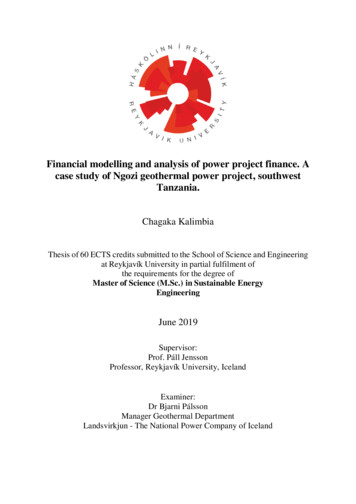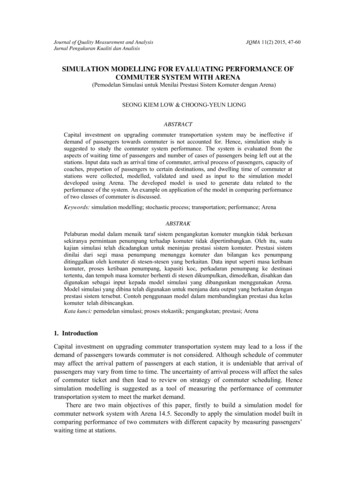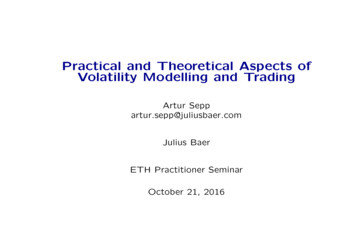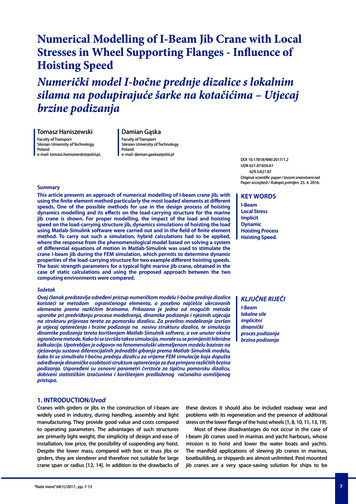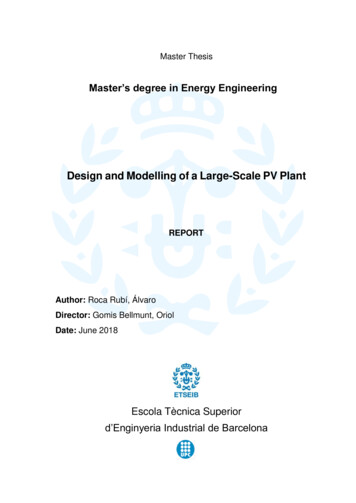
Transcription
Master ThesisMaster’s degree in Energy EngineeringDesign and Modelling of a Large-Scale PV PlantREPORTAuthor: Roca Rubí, ÁlvaroDirector: Gomis Bellmunt, OriolDate: June 2018Escola Tècnica Superiord’Enginyeria Industrial de Barcelona
Design and modelling of a large-scale PV plant1ABSTRACTThe current project is focused on the design a large-scale PV solar power plant, specifically a 50 MWPV plant. To make the design it is carried out a methodology for the calculation of the differentparameters required for the realization of a project of this nature. Subsequently, the different parametersobtained are compared with parameters obtained in literature and with the parameters obtained by meansof specialized PV software (PVsyst and SAM).Before implementing the design calculation methodology, the main components in a large-scale PVplant are described: PV modules, mounting structures, solar inverters, transformers, switchgears and DCand AC cables. Furthermore, the following aspects are analysed in the current project: legislative andadministrative procedures, renewable energy support schemes and environmental aspects associatedwith large-scale PV plants.The calculations regarding the PV plant design are made for a specific location previously selected. Thesite selected for the installation is in the location of l’Albagés (Lledia) which meets all the requirementsfor the installation of a PV plant.The results obtained for four different PV plant scenarios are compared between them in order to obtainthe best possible configuration, the different scenarios combine two different modules and two differentsolar inverters. The calculation methodology is divided in: design calculations, energy calculations,economic calculations and evaluation parameters calculation. The design parameters calculated are thenumber of PV modules in the system, the number of PV modules in series and parallel and the totalinstalled capacity. The main purpose of the energy calculations is to obtain the Annual EnergyProduction (AEP) of the system. The cost associated to the PV project and the Levelized Cost of Energy(LCOE) are obtained by means of the economic calculations. Finally, evaluation parameters such asPerformance Ratio (PR) or Capacity Factor (CF) are calculated.The four different scenarios are modelled by means of PVsyst and SAM and the results obtained arecompared with the results obtained in the calculations. The conclusion obtained is that the resultsobtained with PV software are in accordance with the results obtained by means of the calculationmethodology implemented. The scenario analysed with the best results is the scenario which uses CdTethin-film module technology and the inverters with the highest nominal power. The main resultsobtained for this scenario are: 484,960 PV modules and 14 inverters; Installed capacity of 53.35 MWp;AEP of 83,001 MWh/year with an LCOE of 3.1154 c /kWh; and evaluation parameters are 79,73% ofPR and 17.76% of CF.
Design and modelling of a large-scale PV plant3Contents1.INTRODUCTION . 51.1.2.GOALS AND PROJECT SCOPE . 5PV LARGE-SCALE COMPONENTS . 62.1.SOLAR PV MODULES . 62.1.1.Silicon Crystalline Structure . 72.1.2.Thin Film Technology . 82.2.MOUNTING STRUCTURES . 102.3.SOLAR INVERTERS . 122.4.TRANSFORMERS . 142.5.SWITCHGEAR . 162.6.DC AND AC CABLES . 163.LEGISLATIVE AND ADMINISTRTIVE PROCDEDURES . 184.RENEWABLE ENERGY SUPPORT SCHEMES . 214.1.SUPPORT SCHEMES IN SPAIN . 225.ENVIRONMETAL IMPACTS ASSOCIATED WITH LARGE-SCALE PV PLANTS . 246.LARGE-SCALE PV PLANT DESIGN . 256.1.SITE IDENTIFICATION . 256.2.METHODOLOGY OF CALCULATION . 336.2.1.Design and Energy Calculations . 336.2.2.Economic Calculations . 436.2.3.Evaluation Parameters Calculation . 456.3.7.RESULTS OBTAINED . 476.3.1.Economic Results . 556.3.2.Other Results . 59RESULTS COMPARISON USING PV MODELLING SOFTWARE . 617.1.PVsyst MODELLING . 617.1.1.Pre-Design Phase. 617.1.2.Design Phase . 637.1.3.Results Obtained with PVsyst . 657.2.SAM MODELLING . 787.2.1.8.Results Obtained with SAM . 80CONCLUSIONS . 848.1.Future Work . 86References . 88ANNEX A . 92A.PV PLANT DESIGN METHODOLOGY. MATLAB CODE. 92
A.1. DESIGN AND ENERGY CALCULATIONS . 92A.2. ECONOMIC CALCULATIONS . 94A.3. EVALUATION PARAMETERS CALCULATIONS . 95
Design and modelling of a large-scale PV plant51. INTRODUCTIONDuring 2015, in Paris was held the United Nations Climate Change Conference, also known as COP21.In that conference the so-called Paris Agreement was reached and signed by most of the major CO2emitting countries. The aim of the Paris Agreement is the reduction of greenhouse gases emissions bysetting a limit of global warming below 2ºC compared to pre-industrial levels. To comply with theagreements reached in Paris, the countries involved have to consider the decarbonisation of their energysupply since 65% of the global CO2 emissions come from burning fossil fuels and 81% of the totalprimary energy supply is based on fossil fuels [1]. One of the ways to decarbonize the energy supply ofa country, and probably the only way completely effective, is to make a change towards an energysystem with a higher penetration of renewable energy. Photovoltaic solar power plants are nowadaysthe technology most extended regarding renewable energy generation and since 2016 PV solar energyis the technology with higher growth [2]. The main factor driving the rapid growth of the PV solarcapacity is mainly economic, PV solar power plants have reduced their associated cost by 70% [2]. Thetotal cost reduction in PV solar power plants is caused by cost reduction due to technologicalimprovements, economies of scale in manufacturing and innovations in financing [3]. Furthermore, thegrowing of PV capacity due to cost reduction is not expected to stop in the next years, but it is exceptedto increase the growth of PV in the future. In 2014, according to IFC [3] total PV installed capacityworldwide was 137 GW with annual additions of approximately 40 GW. Traditionally, the area withpractically the totality of the total share of installed PV capacity was Europe, but since 2013 the installedPV capacity in other areas, especially in Asia-Pacific, has grown very rapidly. In 2016 Asia-Pacificbecame the zone with the highest share of installed PV capacity surpassing Europe. In this contextregarding the energy situation in the world and the role of the PV solar power plants is found the projectcarried out.1.1.GOALS AND PROJECT SCOPEThe main objective of the project is the design and modelling of a 50 MW PV solar power plant byimplementing a calculation methodology. By means of the calculation methodology the followingparameters of the PV plant are pursued to obtain through the course of the project: configuration of thePV plant (number of PV modules, number of inverters and how they are connected between them);energy produced by the PV plant; and performance parameters of the plant which can be used to comparethe results obtained. Purely electric aspects are not assessed in detail in this project. Another importantgoal of this project is to make the design of the PV plant economically viable, thus an economic analysisof the PV plant is included in the project, without going into detail in financing models. The lastobjective of the project is to validate the results obtained by means of specialized software.
2. PV LARGE-SCALE COMPONENTSIn this chapter of the project a description of the main components forming a large-scale PV solar powerplant is done. The elements described below are going to be considered during the calculations used forthe system design. The components described are: PV modules, inverters, transformers, switchgears andAC and DC cables.2.1.SOLAR PV MODULESPV modules convert the solar radiation directly into electric energy by means of the photovoltaic effect,doing this process in a silent and clean manner. There are many different PV modules technologies andnowadays research institutions are making efforts to discover new materials and designs with which theperformance of the solar cells can be improved. There are different types of solar cells and theirclassification can be seen in Figure 2.1. In this project, the two major families of solar cells dominatingthe market are going to be explained in more detail in this section: silicon crystalline structure and thinfilm technology.Figure 2.1. Solar PV technologies classification.In Figure 2.2 the production share of silicon crystalline structure (multicrystalline-Si andmonocrystalline-Si) and thin-film technology can be seen. In the early years of photovoltaics, mono-Sipractically monopolized the production, and as the years went the production of multi-Si has becomemore important. The production of thin-film technology remains more or less constant over the years.
Design and modelling of a large-scale PV plant7Figure 2.2. Production share of different technologies over the years. Source: Statista [4]2.1.1. Silicon Crystalline StructureThe first generation of PV modules exiting were silicon crystalline structure modules, despite siliconcrystalline technology was the first PV module technology developed, it is not nowadays obsolete andsome improvements have been made in recent years regarding this technology, in fact it is still the mostused PV module technology [5].Usually the installation of PV modules requires a larger investment cost than the cost associated withoperation and maintenance. Although some governments give very attractive incentives for theinstallation of PV systems, normally the payback time of these projects is long. Because of that it iscrucial to decrease the cost of production by increasing the efficiency of the modules.In the family of silicon crystalline structure can be found monocrystalline photovoltaic cells, polycrystalline photovoltaic cells and back-contact photovoltaic cells.Monocrystalline photovoltaic cellThis technology was in the early years of photovoltaics the module technology most commonly used,both in utility-scale scale and stand-alone applications. But, as years went mono-Si modules have beenlosing market share.The manufacturing process of mono-Si modules is called Czochralski process which is a method ofcrystal growth used to obtain single crystals. The processes consist on melting a high-purity,semiconductor-grade silicon. Boron or phosphorous can be added as dopant impurity atoms, thuschanging the silicon into p-type or n-type, with different electronic properties. By controlling thetemperature gradient and the mechanical strengths of the process it is possible to extract a large singlecrystal from the melt [6].
According to Green et al. [7] the maximum efficiency achieved under STC for monocrystalline solarcell is 26.7%. Despite of the maximum efficiency record achieved, the module efficiencies normallytends to be lower than cell efficiency due to internal electrical losses. Anyway, the record of efficiencyregistered by NREL for a PV module is 20.4 % for a SunPower PV module [5].Multicrystalline photovoltaic cellMulticrystalline solar cells or also called poly-crystalline (or poly-Si) solar cells are the result of tryingto reduce the costs of production of mono-Si cells by means of new crystallization techniques. Thismanufacturing technique consists on producing multicrystalline silicon by melting silicon andsolidifying it to orient crystals in a fixed direction, the ingot of multicrystalline silicon produced is slicedinto blocks and then into a thin wafer [8]. Multicrystalline cells can be easily recognizable because ofthe aspect of metal flake effect caused by the multiple small silicon crystals that forming it.The efficiency of this type of solar cells is significantly lower than monocrystalline solar cells, theefficiency record achieved by a multicrystalline according to Green et al. [7] under STC condition is21.9%. But, once again when looking at commercial available technology the efficiency is lowercompared to laboratory test, the efficiency for multicrystalline modules available in the market is in therange from 14% to 19% [9]. Despite of the lower efficiency of this technology, the main advantage ofmulti-crystalline solar cells respect other solar cell technologies is the reduction of cost achieved bysimplifying the manufacturing process.Back-contact solar cellAlso called rear-contact solar cells have increased the efficiency respect other technologies achievedthrough a better cell design rather than material improvements [5]. This can be achieved by moving allor part of the front contact grids to the rear of the device [10]. The main advantage of this silicon modulesis that shading losses are zero and the contact resistance is low [11]. There are four different backcontact cells technologies: metallization wrap through, emitter wrap through, interdigitated back-contactand advanced back-junction solar cells. All these different technologies of back-contact solar cells arealready being used for different industrial processes.2.1.2. Thin Film TechnologyRelated to the effort to make PV technology less costly, and hence to make more economically viableprojects, appears a new technology called thin-film solar cells [5]. Wolf and Lofersky discovered thatby decreasing the cell thickness, open circuit voltage increases due to reduced saturation current anddecreasing the geometry factor [12]. Thin-film technology consist on thin layers of a semiconductormaterial applied to a solid backing material [9]. Using this technology, the amount of required material
Design and modelling of a large-scale PV plant9is reduced without compromising the lifespan of the photovoltaic cell or being hazardous for theenvironment. Additionally, the cost of production is also reduced due to the photovoltaic materials usedare cheaper than those used for crystalline structures [5]. The market share of thin-films is 15-20%, andthe market growth in the recent years of this technology have been enormous [5].The main advantage of thin-film technology is the reduced thickness of the layers, few micronscompared with the thickness of crystalline modules (several hundreds of microns) [5]. Furthermore, thevery low thickness of the layers provides flexible properties. On the other hand, the fact that thin-filmtechnology involves less photovoltaic material per cell has repercussions on lowering the capacity. But,the capability of this technology to deposit many different materials and alloys leads to improvementsin efficiency. Degradation of this technology is also an important aspect to consider, the majority ofthin-film cells need an extra barrier to protect them from heat or moist which can accelerate their processof degradation [5].Amorphous silicon cellAlso called silicon thin-film solar cell is one of the first thin-film technologies developed and also themost commonly used [5] [9]. The main difference between amorphous silicon and crystalline siliconstructure is the fact that in this technology the atoms of silicon are distributed randomly and not forminga crystalline matrix. An important disadvantage of this type of photovoltaic cells is the fact that theirefficiency is lower than monocrystalline and multicrystalline solar cells, the maximum efficiencyachieved in laboratory test is around 10.2% [7]. But, the efficiency for commercially available cells isin the range from 5% to 7% [9]. Despite of the lower efficiency compared with other technologies,amorphous silicon cells are also an attractive alternative because they are less costly due to their specificmanufacturing process. Silicon is an abundant non-toxic material which requires low processtemperature, enabling module production on flexible and low-cost substrates [13].In order to upgrade the efficiency of this type of solar cells, there are many variations of thin-film siliconsolar cells, the most popular variations are: amorphous silicon carbide (a-SiC), amorphous silicongermanium (a-SiGe), microcrystalline silicon (µc-Si), amorphous silicon-nitride (a-SiN) andhydrogenated amorphous silicon (a-Si:H) [9].Tandem solar cellTandem solar cells were designed in order to increase the efficiency of a-Si solar cells in a cost-effectivemanner. This technology consists on depositing two or more PV junctions on top of the other where thelayer of a-Si is located at the top [5]. This configuration of the solar cell provides an improved range ofefficiency 8-9% [5].
Cadmium telluride cellCadmium telluride (CdTe) cells are one of the most promising PV materials, since this material has theideal band gap (1.5 eV) with a high direct absorption coefficient, thanks to these two parameters with afew of micrometres of this material is enough to absorb around 90% of the incident photons [13].The efficiency achieved in laboratory of cadmium telluride cells is up to 21% [7] and the maximumefficiency achieved for commercially available modules is 9% [5]. This technology is more appropriatefor large scale applications because it is easier to accumulate than other thin-film technologies.The main drawback of this technology is the fact that cadmium is a toxic material, and some measureshave to be adopted in order to not to harm the environment [13]. Another important point is the scarcityof telluride which can have repercussion on the future price of these cells [5].Copper indium diselenide cellCopper indium diselenide (CuInSe2) and copper indium selenide (CIS) cells are a photovoltaictechnology which uses semiconductor elements which are beneficial due to their high optical absorptioncoefficients and good electrical characteristics [5]. By means of adding gallium (CIGS) the band gap ofthe photovoltaic device is increased, this type of technology is known as multi-layered thin-filmcomposites [5].The maximum efficiency achieved for a CIGS thin-film is 19.2% [7] and the efficiency for commerciallyavailable modules is 13% [5]. As happened with telluride in CdTe cells, scarcity is also an issue withindium which in addition is a very common material in electronic applications. Because of this fact,recycling is going to be a crucial aspect for the future growth of these technologies.2.2.MOUNTING STRUCTURESMounting structures are used to fix the PV modules to the ground and they determine the tilt angle andthe orientation of the modules. A classification of the mounting structures can be done depending ontheir assembly to the ground [14]:-Pole mounts. Mounting structures are directly installed into the ground or embedded in concrete.-Foundation mounts. Structures are fixed into the ground by means of concrete slabs or pouredfootings.-Ballasted footing mounts. Mounting structures do not penetrate into the ground and are fixed toit by means of the weight of concrete or steel bases.
Design and modelling of a large-scale PV plant11The selection criteria of the mounting structures involve many factors such as: cost of manufacturing,cost of installation and difficulty of installation, lifespan of the structures, resistance to corrosion orprotection against adverse climatic conditions.Besides, mounting structures are the responsible to endow to the PV modules the required tilt angle andorientation. Regarding this aspect there are two main categories of mounting structures: fixed structuresand tracking axis systems. Fixed structures are not capable to modify neither the orientation nor the tiltangle. This option is the less costly system, but the energy production will be not optimum. Trackingaxis systems can be divided in 1-axis tracking systems and 2-axis tracking systems, the differencebetween both systems is the number of degrees of freedom (see Figure 2.3). Again, there is acompromise between the cost of the system and the energy production of the PV plant, 2-axis trackingsystem is better than 1-axis tracking systems in terms of energy capture, but it is more expensive tomanufacture, to install and also the maintenance is more complex.Figure 2.3. Left 1-axis tracking system. Right 2-axis tracking system. Source: [15]Another aspect to treat when looking at the mounting structures are the shading losses. Tracking systemsusually generate more shading losses than fixed systems due to the movement of the PV panels, notethat for higher tilt angle of the modules, inter-row spacing has to be higher or the shading losses will belarger. The space required for a typical fixed system is in the range of 1.6 to 2.4 ha per MW, while thespace occupation for a typical 1-axis tracking system can be in the range of 1.8 to 3 ha per MW [16].Because of that reason the sizing of the system and the inter-row spacing of the PV modules should bestudied in detail in order to not have unacceptable shading losses. For a good plant design, thecomparison between a PV plant using tracking system and without tracking system can be seen in Figure2.4.
Figure 2.4. Comparison between output power obtained without tracking system (blue) and with tracking system (yellow).Source: [3]Tracking systems integrated in the mounting structures can be controlled by sensors or by controlalgorithms which allows to control the system automatically. There is also one specific type of 1-axistracking system where the change of the tilt angle is done manually and with the change of season(seasonal tilt angle). By changing tilt angle once in winter and once in summer it is achieved animprovement over fixed system regarding the energy capture.Sensor based control systems use sensors to determine the relative position between the sun and the PVmodules. Once the system detects the tilt angle (or orientation) of the PV module is not the optimum themodules are tilted to achieve the optimum angle by means of actuators or motors [16]. Differenttechnologies are used in these systems including light dependant resistors, photo transistors, mini solarcells or complementary metal-oxide-semiconductors (CMOS) [16].Algorithm based control system uses GPS to determine the position and altitude of the sun. Thistechnology helps to develop predictions models of sun’s position which allows to the tracking systemto rotate the PV modules in a continuous and smooth manner [16]. One of the advantages of this trackingsystem respect to sensor-based control system is that algorithm-based control system cannot be disturbedby clouds or other perturbations [16].2.3.SOLAR INVERTERSSince PV modules generates power at DC current, at some point this generated electricity is needed tobe converted into AC current to accomplish with grid requirements. Distribution inside the PV plant canbe done in DC current, and also the power delivered to the grid can also be in DC, but nowadays, ACtechnology seems to be the most realistic and affordable technology to operate. To invert the polarity ofthe source to AC and to synchronize the power generated with the grid an inverter is required. The
Design and modelling of a large-scale PV plant13requirements which solar inverters have to meet in any grid-connected installation are two: performancerequirements and legal requirements [17]. Performance requirements includes: efficiency, powerdensity, installation cost and minimization of leakage current. The category of legal requirementsincludes: galvanic isolation, anti-islanding detection, and other technical codes (Table 2.1).Table 2.1. Legal requirements of utility-scale inverters. Source: [3]StandardDescriptionEN 61000-6-1:2007Electromagnetic compatibility (EMC). Generic standards. Immunity for residential, commercialand light-industrial environments.EN 61000-6-2:2007EMC. Generic standards. Immunity for industrial environments.EN 61000-6-3:2007EMC. Generic standards. Emission standard for residential, commercial and light-industrialenvironments.EN 61000-6-4:2007EMC. Generic standards. Emission standard for industrial environments.EN 55022: 2006Information technology equipment. Radio disturbance characteristics. Limits and methods ofmeasurement.EN 50178: 1997Electronic equipment for use in power installations.IEC 61683: 1999Photovoltaic systems. Power conditioners. Procedure for measuring efficiency.IEC 61721: 2004Characteristics of the utility interface.IEC 62109-1&2: 2011-2012Safety of power converters for use in photovoltaic power systems.IEC 62116: 2008Islanding prevention measures for utility-interconnected photovoltaic inverters.PV inverters can be classified in different topologies [18]. The topology of the solar inverter willdetermine the connections between the PV modules and the inverter and their possible applications.Different topologies of PV inverters can be seen in Figure 2.5.A) Central inverters: range of 100-1000 kW with three-phase topology and modular design forlarge power plants (tenths of MW) with unit sizes of 100, 150, 250, 500 or 1,000 kW.B) String inverters: for small roof-top plants with panels connected in one string (0.4-2 kW).C) Multistring inverters: for medium large roof-top plants with panels configurated in one totwo strings (1.5-6 kW).D) Module integrated inverters: for very small PV plants (50-400 W).E) Mini central inverters, typically 6 kW for larger roof-tops or smaller power plants in therange of 100 kW and typical unit sizes of 6, 8, 10 and 15 kW.
Figure 2.5. PV inverter topologies: (a) Central inverter, (b) String inverter, (c) Multistring inverter and (d) Moduleintegrated inverter. Source: [19]Because of the purpose of this project is the design and modelling of a large-scale PV solar power plant,in this section the attention will be focused on central inverters. The most used central invertersconfiguration is two-level voltage source inverter (2L-VSI) which is composed of three half-bridgephase legs connected to a single dc-link [17]. Another configuration, but in this case less maturetechnology are three-phase 3L-NPC and three phase 3L-T converters [17]. The main advantages ofcentral inverters are the reliability and robustness compared with other inverter’s topologies, but themain drawbacks of this technology are the increased mismatch losses and the absence of MPPT for eachstring of the array connected [3].Normally, the inverters installed in large-scale PV solar power plants are containerised type. This typeof commercially available inverters also contains the transformer and the switchgear in the samestructure. With this solution, inverte
Design and modelling of a large-scale PV plant 1 ABSTRACT The current project is focused on the design a large-scale PV solar power plant, specifically a 50 MW PV plant. To make the design it is carried out a methodology for the calculation of the different parameters


